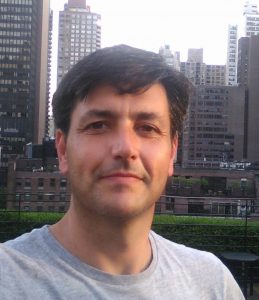 Prof. Fernández Nieto is full professor of Applied Mathematics in the University of Seville. At present he is director of the Dept. of Applied Mathematics I of the US. He develops long-term collaborations with the EDANYA team of C. Parés and M. Castro (U. Málaga), with the research groups of A. Mangeney (Institut de Physique du Globe, Paris), F. Bouchut (Université Marne-la-Vallée, Paris), P. Vigneaux (ENS Lyon) and R. Bürger (U. Concepción, Chile), between others.
Prof. Fernández Nieto is full professor of Applied Mathematics in the University of Seville. At present he is director of the Dept. of Applied Mathematics I of the US. He develops long-term collaborations with the EDANYA team of C. Parés and M. Castro (U. Málaga), with the research groups of A. Mangeney (Institut de Physique du Globe, Paris), F. Bouchut (Université Marne-la-Vallée, Paris), P. Vigneaux (ENS Lyon) and R. Bürger (U. Concepción, Chile), between others.
At this moment he has more than 50 publications in WoS, in addition to other publications and book chapters. He has co-advised 6 Ph.D. theses. The first one together with M. J. Castro, from the University of Málaga. The second Ph.D. thesis was co-advised with Didier Bresch, research director of the CNRS at the University of Chambéry, France. The third one has been co-advised with C. Galán, Architec from the University of Sevilla in 2017. The PH.D. thesis, in june 2018, was co-advised with G. Narbona from the University of Seville. From the University of Concepción, in Chile, co-advised with professor R. Bürguer in 2019. Also with G. Narbona and two architects, J. Sendra and R. Suárez, I have co-advised the last Ph. D. Thesis in the University of Seville in 2020.
He has been invited speaker in eighteen conferences and international schools. He have been principal investigator of three national project, calls 2013-2015, 2015-2018, and currently of another of the call 2019-2022, funded by the Ministry of Economy, Industry and Competitiveness. He has been researcher of the European project ETC-ITN network «Modeling and Computation of Shocks and Interfaces». He have participated as researcher in two national projects funded by the Ministry of Science and Economy and three projects of excellence funded by the Department of Innovation and Science of the Junta de Andalucía. As well as in two integrated actions, one with France and the other with Italy. In addition, He have also directed two project of transference of technology for developing countries with researchers from Burkina Faso.
Awards
- His doctoral Ph.D. Thesis (advised by iMAT’s Scientific Director), dealing with the modeling of the toxic waste in Aznalcóllar town, received the 2004 Seville City award.
- He also received the young researcher award from the Spanish Society of Applied Mathematics in 2009.
Main research results
- His main contributions deal with mathematical modeling, with applications to geophysics and recently to architecture. He has also developed numerical schemes for the approximation of hyperbolic PDEs, mainly finite volume type schemes. He has worked on real-world applications of the models by means of comparisons with laboratory data.
- We can highlight his contributions to the study of tsunamis generated by submarine avalanches. He introduced a coupled model for shallow flows that has been used in a large number of applications in real flows. He has recently improved this depth-averaged model, using different averaged directions for the fluid and the granular layers. This is a key contribution to correctly predict the initial position and velocity of the generated wave.
- He has contributed to develop a new type of multilayer models that recover a variable vertical velocity, without needing a vertical grid. He has also introduced a hierarchy of non-hydrostatic multilayer models which are a generalization of depth-averaged dispersive models, that bears energy-conservation properties. This methodology has been applied in fluids, poly-disperse sedimentation and granular flows. Comparisons with experimental data show the excellent accuracy of these models.
- He has studied experimental bedload sediment transport models, showing that they can be deduced directely from an asymptotic analysis of the Navier-Stokes equations, including gravitational effects, which are not usually taking into account or are not correctly introduced in the bibliography.
- He has also introduced the PVM finite volume methods, with low computational cost, which include a large part of classic schemes within a unified formulation, and that allows to readily define efficient and accurate new methods.

